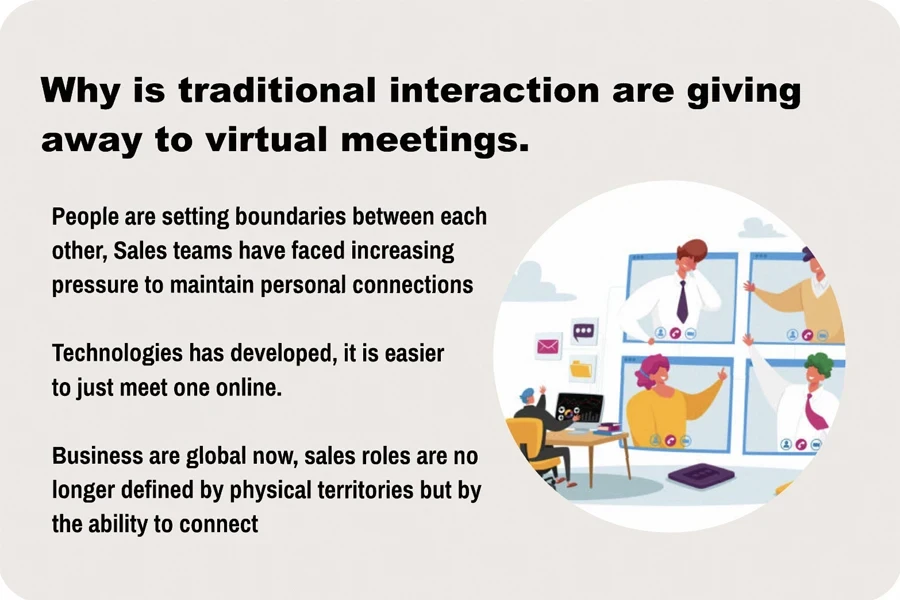Table of Contents
● Introduction to Modern Sales Challenges
● Evolution of Sales Roles: Adapting to a Digital First Approach
● The Rise of Digital Tools in Sales: A New Frontier
● Adapting Sales Strategies for Digital Excellence
● Conclusion
In the ever-evolving landscape of sales, the recent shifts from traditional practices to a digital-first approach have been both rapid and transformative. As the global market grapples with unprecedented challenges, sales professionals find themselves at a crucial junction—adapting to a digital environment that demands new skills and strategies. This article delves into how the roles of inside and outside sales are converging under the influence of digital tools, reshaping the way sales are conducted and success is achieved. We will explore the necessary tools and strategies that are setting the stage for a future where digital proficiency is not just an advantage, but a necessity.
Introduction to Modern Sales Challenges
The sales landscape has undergone a seismic shift, propelled by rapid technological advancements and changing market dynamics influenced by global events in the last pandemic era. Traditional face-to-face interactions quickly gave way to virtual meetings, forcing sales professionals to rethink their approaches and tools.

This transition was not just about changing the medium of communication but also about re-evaluating what customers value most in the digital age. Sales teams have faced increasing pressure to maintain personal connections and trust without the benefit of physical presence, necessitating a deep understanding of digital engagement tools and techniques. These challenges underscore a broader transformation within industries—sales roles are no longer defined by physical territories but by the ability to connect, solve, and sell in a digitally enabled environment. Adapting to these changes requires a blend of agility, technological proficiency, and a reimagined view of customer relationships, setting the stage for the evolving sales strategies we will explore next.
Evolution of Sales Roles: Adapting to a Digital First Approach
The distinction between inside and outside sales roles is blurring, with the digital realm leveling the playing field in unprecedented ways. Previously, outside sales reps thrived on in-person engagements, leveraging physical meetings to build relationships and close deals. However, the shift towards remote working necessitated by health and safety concerns has accelerated the adoption of digital tools across all sales functions.

Inside sales teams, traditionally confined to office environments and phone or email interactions, are now stepping into roles that demand more strategic, consultative selling traditionally reserved for their outside counterparts. This convergence of roles means that all sales professionals must be adept at using digital platforms not just for communication, but for negotiation, presentation, and closing deals. The ability to harness CRM systems, video conferencing tools, and digital sales aids effectively has become integral. Sales professionals are thus evolving from their specialized silos into more versatile roles where digital literacy is as crucial as traditional sales acumen.
The Rise of Digital Tools in Sales: A New Frontier
The integration of digital tools into sales processes is transforming how sales teams operate, meanwhile, how they engage with customers and track progress towards goals. Tools like CRM systems, AI-driven analytics, and virtual meeting platforms are no longer just support mechanisms but central to daily sales operations. These tools provide sales professionals with detailed insights into customer behavior, preferences, and potential pain points, allowing for a more personalized approach to sales than ever before. Moreover, digital tools enable a level of scalability and efficiency that traditional methods cannot match.
- CRM Systems 💻: Customer Relationship Management (CRM) systems are vital for managing customer data, tracking interactions, and automating sales processes. These systems provide a centralized platform for sales teams to manage their relationships with customers and prospects effectively.
- AI-driven Analytics 🤖: Artificial intelligence (AI) in sales analytics allows for the automation of data collection and analysis, offering insights into customer behavior, sales trends, and potential opportunities. AI can predict customer needs and sales outcomes, helping sales teams to be more proactive and efficient.

- Virtual Meeting Platforms👨: With the rise of remote work, virtual meeting platforms like Zoom, Microsoft Teams, and Google Meet have become essential for conducting sales meetings and presentations. These tools help maintain personal connections with clients and teams despite geographical distances.
- Sales Automation Tools 🔧: These tools automate routine sales tasks such as email marketing, lead generation, and follow-ups. Automation helps free up sales reps to focus on more strategic tasks and ensures that no part of the sales process is overlooked.

- Social Selling Tools: Platforms like LinkedIn Sales Navigator allow sales professionals to leverage social media for lead generation and relationship building. These tools enable sales teams to reach out to prospects in a more informal yet professional way.
- E-commerce Platforms: For businesses directly selling online, e-commerce platforms integrate sales, inventory, and customer management. Tools like Shopify and Magento offer scalable solutions that can grow with the business.
- Data Visualization Tools 🔢: Tools like Tableau or Google Data Studio help sales teams visualize data trends and metrics, making it easier to digest complex information and make informed decisions quickly.
This expansive arsenal of digital tools not only enhances the efficiency and effectiveness of sales processes but also redefines the art of selling by empowering teams with the technology to excel in today’s digital-driven market.
Adapting Sales Strategies for Digital Excellence
As the sales environment becomes increasingly digital, the strategies employed by sales teams must evolve to keep pace with the technological advancements and shifting buyer expectations. The key to success in this digital age lies not just in adopting new tools, but in integrating them seamlessly into a holistic sales strategy. This requires a reevaluation of traditional sales tactics and a shift towards more strategic, data-driven approaches. Sales leaders must foster a culture of continuous learning and adaptability, encouraging their teams to embrace digital tools and techniques wholeheartedly. Effective digital sales strategies involve not only understanding the functionalities of various platforms but also leveraging them to enhance engagement and customer experience.

For example, using analytics to tailor communications and offers to individual customers can significantly increase conversion rates. Additionally, virtual selling, which includes video presentations and digital content sharing, needs to be as engaging and persuasive as in-person meetings. Sales teams that can master the art of digital persuasion and virtual relationship-building will thrive in this new era. This shift towards strategic, digitally enabled selling is crucial for capturing competitive advantage and driving long-term success in a rapidly evolving marketplace.
Conclusion
The transition to a digital-first sales landscape is not just a temporary adaptation but a fundamental shift in how sales are conducted. As we have explored, the convergence of inside and outside sales roles, coupled with the rise of digital tools, has created a new frontier for sales professionals. These changes demand a robust adaptation strategy that encompasses not only the adoption of technological tools but also a significant transformation in sales methodologies and mindsets. Sales leaders and their teams must be agile, continuously learning, and ready to embrace new ways of engaging with customers. The future of sales is here, and it is digital. By understanding and implementing the strategies discussed, sales professionals can ensure they are not only prepared but also ahead of the curve in this dynamic new sales environment.




